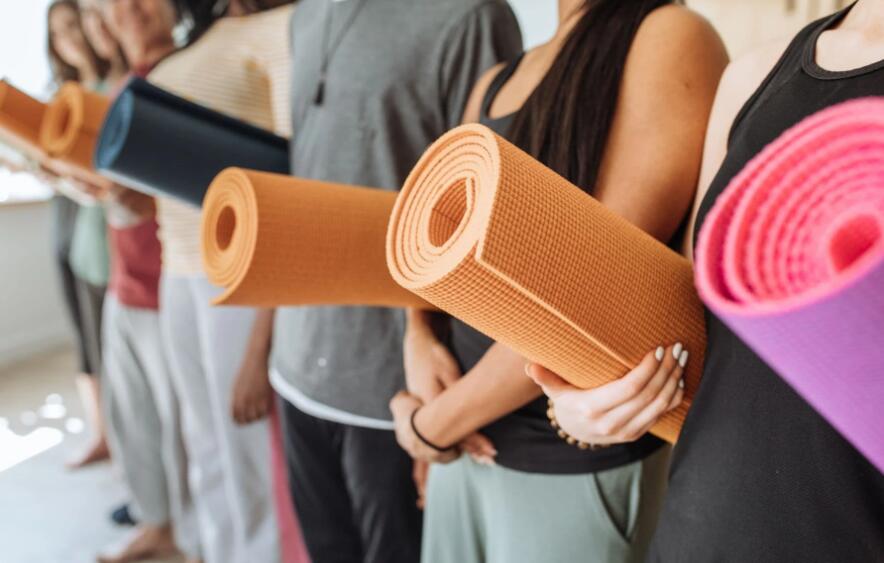The ongoing discussion surrounding the ideal thickness of yoga mats continues to captivate yoga enthusiasts worldwide.
This article aims to offer a comprehensive analysis of the advantages and considerations associated with both thick and thin yoga mats, assisting individuals in finding their perfect match.
The Case for Thin Yoga Mats

A thinner mat fosters a stronger connection with the floor, promoting better stability and balance during yoga poses. Improved proprioception allows practitioners to fine-tune their alignment and deepen their practice.
Enhanced Stability and Connection:
A thinner mat fosters a strong connection with the ground, allowing the practitioner to establish a solid foundation for their yoga practice. The closer proximity to the floor enhances balance and stability during various poses, particularly standing balances and inversions. By feeling the ground beneath them, yogis can deepen their practice and refine their alignment, leading to increased body awareness and precision in each movement. Portability and Convenience:
Thin yoga mats are incredibly lightweight and easy to carry, making them a convenient choice for yogis on the move. Whether you’re attending a class at a studio or taking your practice outdoors, a thin mat can be effortlessly rolled up or folded, taking up minimal space in your bag. This portability factor makes thin mats ideal for individuals who travel frequently or those who have limited storage capacity at home.
Ideal for Advanced Practitioners:
Experienced yogis who prioritize precision and fluid transitions may prefer thin mats for their practice. These mats provide a more direct experience, making it easier to feel the subtle shifts in the body and make adjustments accordingly. With minimal padding, advanced practitioners can refine their movements and engage their muscles more effectively, unlocking new levels of control and refinement in their yoga practice.
The Advantages of Thick Yoga Mats

Thick yoga mats are favored by many for their superior cushioning and impact absorption capabilities, providing extra comfort and joint support during yoga practice.
Superior Cushioning and Joint Support:
One of the primary advantages of thick yoga mats is their ability to offer superior cushioning and support for the joints. This is particularly beneficial for individuals with sensitive joints or those recovering from injuries. The extra padding acts as a buffer, reducing the pressure exerted on the knees, wrists, and other vulnerable areas, minimizing the risk of discomfort or strain during weight-bearing poses.
Enhanced Comfort for Longer Practices:
Thick mats provide a plush and comfortable surface that caters to longer yoga sessions or practices that involve extended periods of seated postures. The added cushioning relieves pressure on the body, making it easier to maintain poses without discomfort or fatigue. This extra comfort encourages practitioners to delve deeper into their practice, exploring the limits of their flexibility, strength, and endurance.
Protection against Hard Surfaces:
Practicing yoga on hard surfaces can be challenging and uncomfortable, especially during floor-based poses or in colder environments. Thick yoga mats act as a protective barrier, providing insulation against cold or hard floors. This added layer of cushioning and insulation ensures a more comfortable practice, allowing yogis to focus on their breath and movements rather than any discomfort from the surface beneath them.
Key Considerations for Individual Needs
Choosing the right yoga mat thickness involves considering various factors based on individual preferences and requirements.
Body Type and Sensitivity:
Body type and weight distribution play a significant role in determining the ideal yoga mat thickness. Individuals with a larger build or more body weight may require a thicker mat to provide adequate support and cushioning for their joints. Additionally, those with joint sensitivity or specific conditions such as arthritis may find that a thicker mat helps minimize discomfort and impact during poses.
Practice Style and Intensity:
The nature and intensity of one’s yoga practice should also be taken into account when selecting mat thickness. Dynamic and high-impact yoga styles, like Vinyasa or Ashtanga, often involve quick movements, jumps, or inversions that benefit from the shock absorption provided by thicker mats. On the other hand, gentle or restorative practices, which focus more on relaxation and slow movements, can be enhanced with the stability and connection offered by thin mats.
Personal Preferences and Practicality:
Personal preferences for firmness, cushioning, and sweat absorption are essential considerations when choosing a yoga mat thickness. Some individuals prefer the firmness and stability of a thin mat, whereas others prioritize the extra cushioning
and comfort provided by a thick mat. It is also important to consider practicality factors such as portability, storage, and maintenance. If you frequently travel or have limited storage space, a thin mat may be more practical, as it is lightweight and easier to roll up or fold. Additionally, individuals who tend to sweat more during their practice may prioritize a mat with better moisture-wicking properties, regardless of its thickness.
Conclusion
Deciding on the ideal thickness for a yoga mat is a personal choice that depends on various factors, including stability, comfort, joint support, practice style, personal preferences, and practicality. A thinner mat offers enhanced stability and connection with the floor, making it a suitable choice for advanced practitioners and those who prioritize a grounded practice. On the other hand, thick mats provide superior cushioning and joint support, ensuring comfort and insulation against hard surfaces, which can be beneficial for individuals with joint sensitivity or those engaging in high-impact yoga styles.
Ultimately, it is important to carefully consider your body type, practice style, and personal preferences when selecting a yoga mat thickness. Experimenting with different mat thicknesses may be necessary to find the optimal balance of stability, cushioning, and support that suits your individual needs. Whether you choose a thick or thin mat, the most important aspect is to find a yoga mat that supports your practice and promotes a positive and enjoyable yoga experience.
